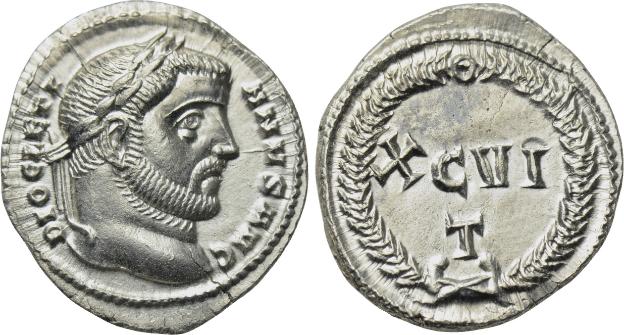
The argenteus denomination was introduced by Diocletian in a coin reform of c. 294. It was a coin the size of denarius and of good silver. Silver coins of this quality had not been seen since the first century under Nero.
The coin to the right is an argenteus of Diocletian (DIOCLETI-ANVS AVG) from Ticinum (T). 20-19 mm. 3.30 grams. "XCVI" is "96" in Roman numerals and gives its value, "96 to the Roman pound of silver." The portrait is in high relief which is common on argentei but not seen on the previous aureliani nor the accompanying folles and radiates. RIC VI Ticinum 20a, "c. 300". Sear IV 12620.
After a substantial output until about AD 300, production tapered off and quit about 310. Constantine resumed minting silver coins with new denominations c. 315, but they are rare. After 337 the silver denomination we know as the siliqua is common.
What's new? 2020, October 27: A VIRTVS MILITVM argenteus of Constantius as Caesar from Antioch.
2020, May 21: Some font sizes enlarged.
History of the Denomination. When Diocletian came to power in AD 284 the coinage system had only two significant denominations. There was no silver denomination. There were only uncommon gold coins of very irregular weights and extremely common low-silver copper radiate "aureliani." The gold was so irregular in weight that it had to be weighed for each transaction. The aureliani (aka "radiates" aka "antoniniani") had at most 5% silver, some of which was in a thin surface-silvering which soon wore off and left the coins looking like copper, which they mostly were.
Diocletian reformed the system. First he regularized the weight of the gold denomination. We now usually call the new denomination an aureus, but ancient sources called it a solidus, which is the name we use for the lighter gold piece introduced under Constantine. Then, c. 294, reforms introduced three new denominations:
1) a new low denomination of copper with no silver which we now call, awkwardly, a "post-reform radiate fraction" (or "post-reform radiate" or "radiate fraction"). Most have legend CONCORDIA MILITVM which was also common on the discontinued aurelianus which had some silver content. New collectors often have difficulty telling them apart (for more about this, see below).
2) the common large (27 mm) laureate coin we now call a "follis", although it probably was called a "nummus" in antiquity. Most have legend GENIO POPVLI ROMANI. (For more about this, see below.)
3) a substantial piece of nearly pure silver we call an "argenteus" (the word simply means "of silver"). Some, but not the initial issues, are boldly labeled "XCVI" for 96, that is, 96 coins to the Roman pound of silver. In weight, size, and quality, argentei are much like the late denarii of Nero (those struck AD 64-68) which were also struck at 96 to the pound. Ideally, they weigh about 3.3 grams, but the Sisak hoard weight distribution [p. 32] is quite broad, with 10% as low as 2.6 grams.
The values, both relative and absolute, of these three denominations remain uncertain and the arguments for their values are discussed below.
Note for collectors: Argentei are rare today. They were issued in the names of rulers of the first tetrarchy (Diocletian and Maximian as Augusti, and Constantius I and Galerius as Caesars) which lasted until 305. However, it is likely that production was intermittent and discontinued at most mints c. 300, to be resumed with much reduced volume in 305 after the retirement of Diocletian. The good-silver denomination was finally abandoned c. 310. A debased version was issued c. 313. Rare silver coinage with new denominations was resumed under Constantine c. 315.
In 1930 Pink found a total of only 530 argentei after an extensive search of both pubic and private collections [RIC p. 441]. In 1953 the huge Sisak hoard (1415 argentei), was found. Published in 1961, it closed c. 295-296 and provides most of the examples known today and, because of its early closing date, has only the early "four sacrificing" issues of the first tetrarchy represented. That one hoard makes the early issues more available than later issues, even if they may not have been more common originally. Many coins in the auction catalog M&M XIII of June 1954 are provenanced to the Sisak hoard. A die study might resolve the question of original issue sizes. What remains today depends upon the chance finding of hoards. If the Sisak hoard had not been found, the relative frequencies of the early and later issues would be much different.
Types: Argentei come with only a few reverse types. The first issues all had four emperors sacrificing over a tripod in front of the gate of a turreted enclosure:
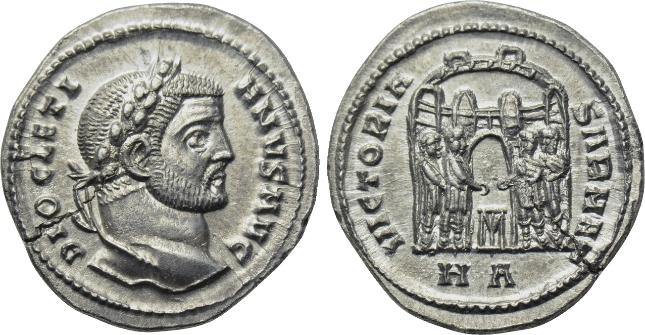
This example is of Diocletian with legend
VICTORIA SARMAT
20-19 mm. 3.31 grams.
The same "four sacrificing" design occurs with legends
VIRTVS MILITVM (second next below)
and
PROVIDENTIA AVGG (see one below)
and
VICTORIA AVGG (no example here, but it is just like the others except for the legend)
RIC Heraclea 6 "c. 295" (All references to RIC are to volume VI.)
Sear IV 12612.
The table below shows all four legends were issued for all four rulers.

This "campgate" example is of Galerius Caesar. 19 mm. 3.31 grams.
with legend MAXIMIA-NVS CAESAR
(Be careful. The emperor we call "Maximianus" is not this Caesar who had a very similar name. Maximians had full name "M. Aurelius Valerius Maximianus" and Galerius had the name "C. Galerius Valerius Maximianus" which differs in the "Galerius" part so in modern times we use that name. Maximian did not mint coins as Caesar and Galerius did, so any coin of "Maximianus" as Caesar is really of Galerius.)
The type is a "campgate" or city gate or watchtower with three "turrets" or tripod signaling towers,
What the wall is and what the three things on top are is uncertain and remain fodder for academic publications.
The reverse legend is
VIRTVS MILITVM
RIC Antioch 43b "c. 298"
The same "campgate" or "gateway" design also appears with legends
VICTORIA AVGG, and
VICTORIA SARMAT, and
CONCORDIA MILITVM.
The last two legends were only at Thessalonica and only for Galerius.
There is a great deal of stylistic variation between mints. Compare that Galerius portrait from Antioch to the next one from Rome:

Galerius, as Caesar,
18 mm. 3.36 grams.
struck at the Rome mint.
VIRTVS MILITVM, four sacrificing.
RIC Rome 29b "c. 294."
On this coin the head takes up much less of the flan and does not have the "bull neck" of the broader coin from Antioch (which has a flan a full millimeter broader as well--the images are on the same scale).
The First Tetrarchy. Here is a table listing the types issued under the first tetrarchy.
(D = Diocletian, M= Maximian, C = Constantius, and G = Galerius)
| design | legend | rulers |
| four sacrificing (c. 294-297) | VIRTVS MILITVM | D, M, C, G |
| " | VICTORIA SARMAT* | D, M, C, G |
| " | PROVIDENTIA AVGG | D, M, C, G |
| " | VICTORIA AVGG | D, M, C, G |
| campgate (c. 297 and later) | VIRTVS MILITVM | D, M, C, G |
| " | VICTORIA SARMAT* | G (Thess #10) |
| " | VICTORIA AVGG | D, M, C, G |
| " | CONCORDIA MILITVM | G (Thess #8) |
| Africa standing (c. 296-8) | FELIX ADVENT AVGG NN** | D, M, C, G |
| XCVI in wreath (c. 300) | none | D, M, C, G |
* The Sarmatian victory type is spelled with various abbreviations: SARMAT, SARM, SARMATI, SARMATIC, SARMATICA, SARMATICAE.
** This type is only from Carthage. FELIX may be abbreviated as FEL or just F. This type is also used on folles (see below).
Varieties: There are many varieties. Argentei were struck at 14 mints (not all mints struck all types). Some have several officina, varieties of mintmark, and obverse legend varieties. In addition to the varieties of the abbreviation SARMAT, the "sacrificing" scene occasionally has the enclosure with eight or four turrets instead of the usual six, and the "campgate" sometimes has open doors and sometimes four "turrets" instead of three.
After the First Tetrarchy (after 305). After the first tetrarchy far fewer argentei are extant and it is likely that some types were minted that were not been recorded in RIC. For example, at Aquileia the campgate type of 305-6 is recorded in RIC only by a unique piece for Galerius as Augustus. It seems likely it was issued at Aquileia for other rulers too, but examples either simply have not survived or remained to be found at the time RIC was written. The sale catalogs listed below have some varieties not in RIC.
In 305 Constantius and Galerius became the new Augusti. Eastern mints had already discontinued the denomination; after 305 the denomination is found only at Serdica, Carthage, Rome, and Aquleia. Constantius and Galerius minted the campgate VIRTVS MILITVM as augusti.
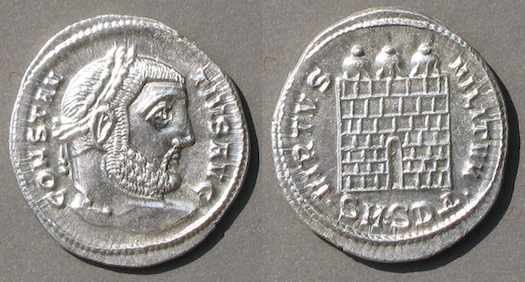
Constantius I, 305-306 as Augustus
at Serdica
20-19 mm. 3.41 grams.
CONSTAN-TIVS AVG
VIRTVS MILITVM, campgate
mintmark •SM•SDΔ•
RIC Serdica 11a, "305-306"
The good-silver argenteus denomination was abandoned c. 310. Three base-silver types from Trier c. 313 may be debased "argentei" and are discussed below. Constantine resumed issuing good-silver coins from central mints c. 315-325 but all are quite rare. In 324 silver began being issued in larger quantities from eastern mints. But, for collectors, silver coins are not common until 337 when Constantine died and his sons began to issue siliqua (and multiples) in large quantities. The silver siliqua denomination remained a significant part of the coinage until the end of the empire (and beyond).
Additional Examples
Because the mint of Serdica was not opened until 303/4 the next coin proves that argentei were still being issued that late, although the XCVI issue attributed to c. 300 is the last issue at most mints.
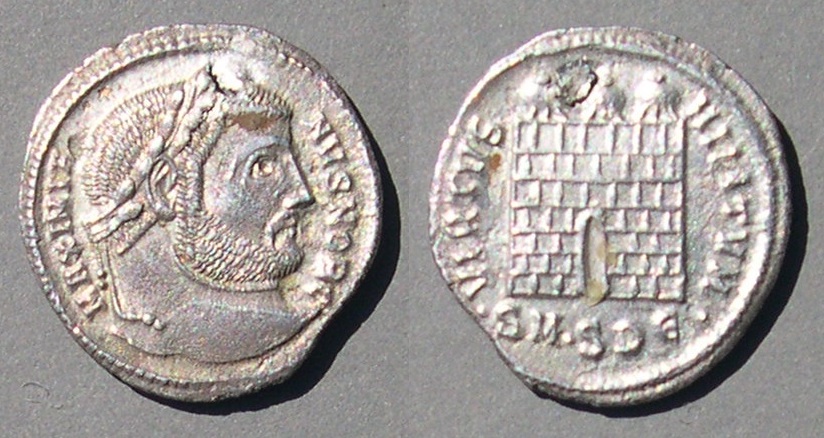
Galerius, Caesar 293-305 and Agustus 305-311
as Caesar from the Serdica mint
20-19 mm. Holed at 12:00. 3.09 grams.
VIRTVS MILITVM, campgate
mintmark •SM•SDE•
RIC Serdica 2b E, "303/4 - 1 May 305"
The Sisak hoard had no coins from Serdica. The hoard closed before the Serdica mint opened.

Constantius I, as Caesar 293-305
18 mm. 2.87 grams.
CONSTANTI-VS CAESAR
PROVIDEN-TIAE AVGG, four sacrificing
HΓ
RIC Heraclea 9, "r5, c. 296"
The next coin is larger in diameter and has a different portrait with Constantius with curls in his beard.

Here is an example of "four sacrificing" with the VIRTVS MI-LITVM legend for Maximian:
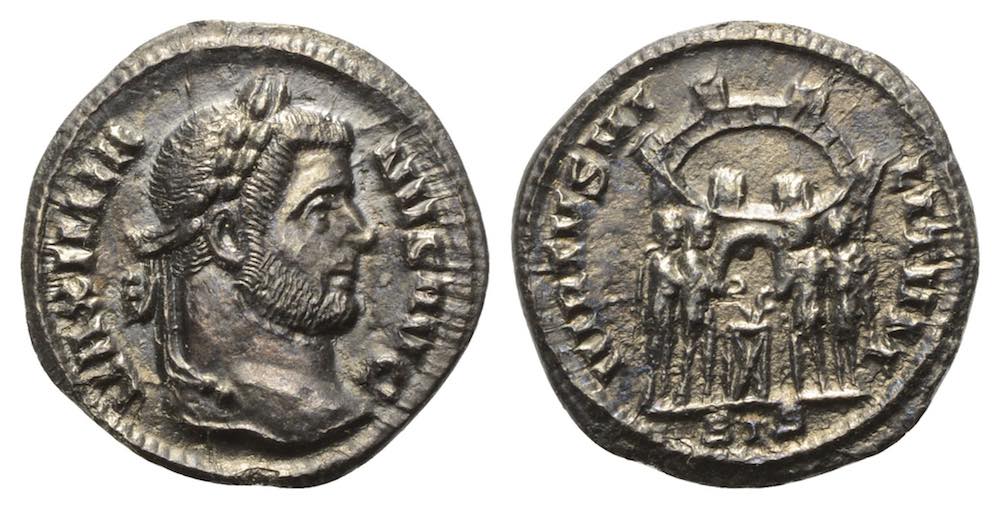
Maximian
18 mm. 2.55 grams.
Struck c. 295
VIRTVS MI-LITVM
SIS
RIC Siscia 52b (with a different reverse legend break)
Jelocnik plate III 7-9 (with a different reverse legend break).
This example is toning towards black.
Here is an example of "four sacrificing" with the VICTORIA SARM legend:

Maximian
18 mm. 3.06 grams.
Struck at Rome (with no mintmark)
High relief.
VICTOR-IA SARM
four sacrificing
RIC Rome 14b, "c. 294."
Here is an example of "four sacrificing" with "VICTORIA SARM" expanded to "VICTORIAE SARMATICAE":

Maximian
19 mm. 3.40 grams.
MAXIMIANVS AVG
four emperors sacrificing over tripod in from of the gate of a camp with towers,
VICTORIAE SARMATICAE and
ALE for Alexandria in exergue, B in field right.
RIC unlisted but in RIC VI on page 661 the corresponding type is listed for Diocletian as Alexandria 8 ("c. 295") and "R4" (this coin would be 8b). The other types of argentei from this first issue at Alexandria are all R5 and the second issue has some "R4" with the VIRTVS MILITVM legend.
The XCVI type of c. 300 was issued in the names of all four tetrarchs. The coin at the top of this page was of Diocletian. Here is one for Maximian:
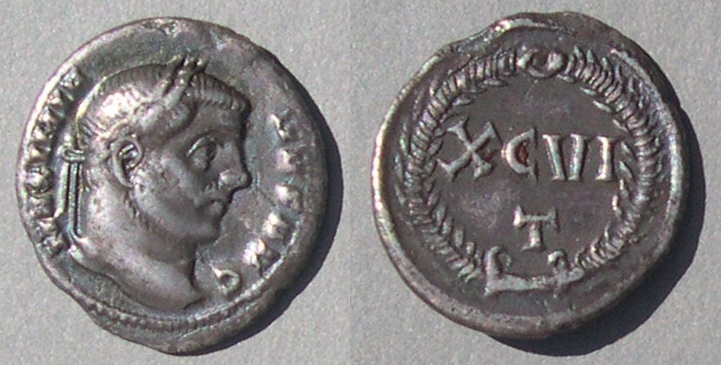
Maximian, first reign 286-305
19-18 mm. 3.47 grams.
High relief.
XCVI over T, in wreath.
RIC Ticinum 20b, "c. 300."
Style. The next two repeat the point that style can vary greatly between mints.
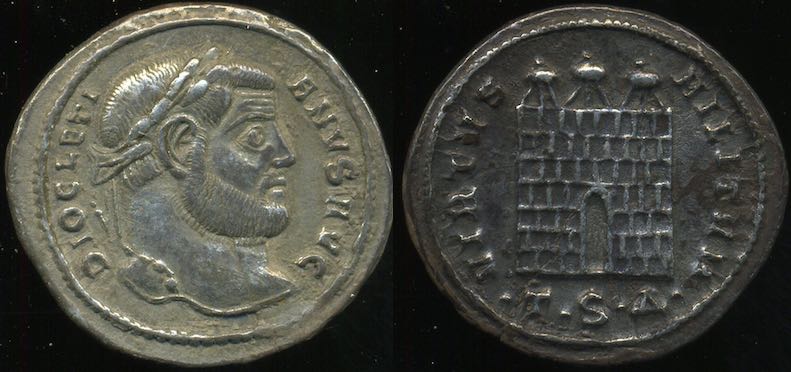
Diocletian, campgate VIRTVS MILITVM from Thessalonica.
Struck c. 302.
20 mm. 3.10 grams. A broad flan with relatively low relief portrait.
•T•S•Δ•
RIC Thessalonica 15a variety (Δ, not A, B, or Γ)
Sear IV 12618 variety (Sear doesn't list Thessalonica for the type).
The Sisak hoard had no coins from Thessalonica.
Note the large, square, head with a short bull neck.
Compare it to the next coin which is smaller in diameter.
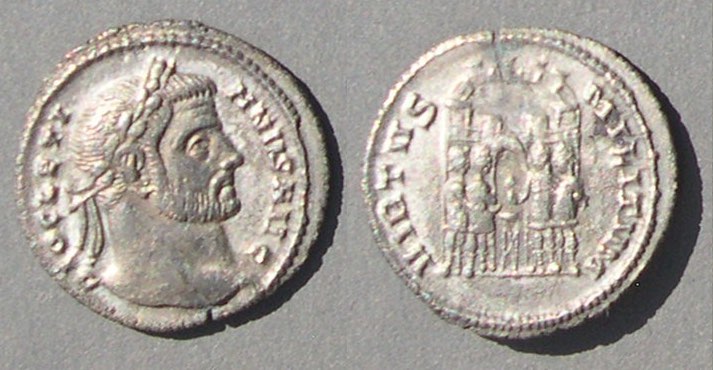
Diocletian, four sacrificing, VIRTVS MILITVM from Siscia
Struck c. 294-295.
18 mm and only 2.66 grams, just above the 10th percentile of possible weights for official issues.
RIC Siscia 32a "c. 294"
Sear IV 12617.
Admittedly, these two coins are not the same type and not from the same year, but they do show significant difference in the portrait of Diocletian, as well as flan size and relief.
Imitations. Whenever there is something of value, someone will try to make money by duplicating it cheaper. Counterfeits immediately followed the introduction of the argenteus.

Ancient imitation
Prototype: Maximian, four sacrificing, VIRTVS MILITVM
18 mm but only 1.79 grams of apparently pretty good, if not pure, silver.
It appears to be struck (not cast) from crudely made dies.
The execution is far from normal and the weight very light. Who would be fooled?

Cast imitation of an argenteus of Maximian in base metal (copper).
Only 16 mm and 1.99 grams.
What was done to the surface to make it pass for official is uncertain. Maybe the technique used to surface-silver the third-century radiates was employed.
The casting seam is visible from 9:00 - 11:00 on the obverse. The syle is perfect; it must have been cast from a genuine coin and the smaller size is the usual result of casts shrinking to smaller sizes than their originals.
The prototype was
VICTORIAE SARMATICAE with a campgate with four turrets and open doors (the campgate above did not show doors and most have three turrets.), a type which exists at Nicomedia (RIC 25b) and is one more variant spelling of VICTORIA SARM.
Mintmark SMNΓ
The reformed radiate. The common post-reform radiate looks a lot like the pre-reform aurelianus, but has no silver instead of perhaps four or five percent silver, which gave the pre-reform coins much more value because silver was worth, by weight, 80 times the worth of copper.

The new "post-reform radiate fraction" of Diocletian from Alexandria.
CONCORDIA MILITVM
It is 21 mm and has no silver, although in design it is much like the aurelianus (next) it replaced which had a small amount of silver, but enough to make it four or five times the intrinsic value of this new denomination.
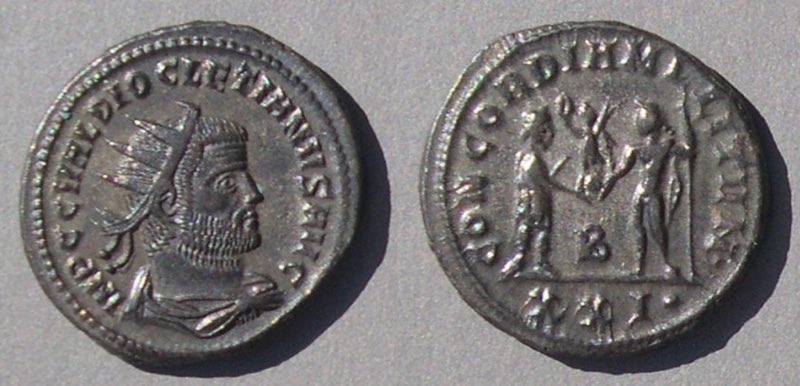
The old denomination, on this example (but not all examples) indicated by the mark "XXI" which proabably means "20 parts copper and one part silver" [Esty, and also discussed below.]
CONCORDIA MILITVM
struck at Cyzicus.
22 mm (almost the same size) and the same type. It is easy to see why they are hard to tell apart. The stylistic differences between these two are at least as much because they are from different mints, not because the two denominations have different styles. The radiate fractions usually have a larger, squarer, portrait.
The "follis." The follis or nummus was a big, well-made, piece of c. 27 mm and 10 grams. Most have no indication of their value, but some do. Unfortunately, it is uncertain what the value marks mean. They are discussed below.
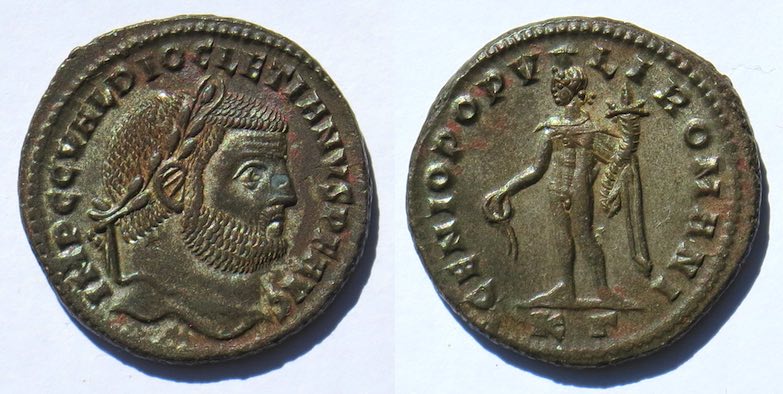
A follis of Diocletain minted at Cyzicus (Kyzikos)
27 mm. 9.78 grams
with the very common
GENIO POPVLI ROMANI, Genius standing left holding patera and cornucopia.
This example shows some of the surface-silvering which added about a percent of silver to the overall alloy [Esty "Surface-silvering"].

This example, from Alexandria, has XX-I across the field and E above the I. Alexandria was in the Greek east so "E" might be a Greek "5". "XXI" is clearly something to do with 20 and 1. "XXI" was common on the aurelianus. From "XXI" on some examples like this one we infer it may have been issued with the same alloy as the previous "XXI" radiates (alloy investigation shows this is close to true), only the follis is much larger.
In 1989 I had this particular coin analyzed at Oxford for silver content and found it to be 3.96% silver, not counting the missing surface silvering. (The metal investigated was beneath a small circle scraped to get down to bare metal. In the photo you can see the region toning to a dull red above the "E" on the reverse.)
This (and many other chemical analyses) is consistent with "20 parts copper and one part silver" for the meaning of "XXI".
Values. The coinage system introduced c. 294 had three new denominations. How they relate to one another and how they fit into "The Edict of Maximum Prices" promulgated by Diocletian in 301 is uncertain, in spite of very many academic articles devoted to the question. The Edict mentions prices in "denarius communes [d.c.]" which is not as helpful to us as it might be because there was no such common coin--it was a money of account. The Wikipedia article on the Edict has a table under "Coinage" that expresses the relative values as if its given numbers are certain, which is not the case. For example, it has the (post-reform) radiate as 5 d.c. and 5 radiates make a follis (= nummus, then of 25 d.c.) and 4 folles make one agenteus. Or, maybe the new radiate was 2 d.c and the old radiate 5 d.c. Both could make the argenteus 100 d.c., for which there is some evidence, so those numbers are one possibility.
One argument is that the "Edict of Maxmum Prices" has many items worth 2 d.c. and very few worth only one. This strongly suggest there was a 2 d.c. coin, and the post-reform radiate must be it. Maybe there is a way to keep the argenteus at 100 d.c. with the radiate at 2 d.c. Maybe the follis was 20 d.c., making 5 in an argenteus and ten radiates in a follis.
Much of the controversy about values swirled around the meaning of "XXI" which is on some pre-reform radiates and some folles. It was so contentious that Callu was able to assemble 21 different proposals for the meaning of "XXI". Evidence from Callu and from Esty shows that "XXI" and "KA" and "XI" are incompatible with XX meaning twenty and X meaning ten of some lower amount, they must, instead, be how many make some higher amount. They are consistent with "20 parts copper and one part silver," which is often accepted as the meaning now.
The names of the denominations and their relative values in antiquity are of never-ending interest and research.
Africa. A personification of Africa appears on coins of Carthage (only) on both argentei and folles with the legend FELIX ADVENT AVGG NN, celebrating the arrival of Maximian. Here is a follis:
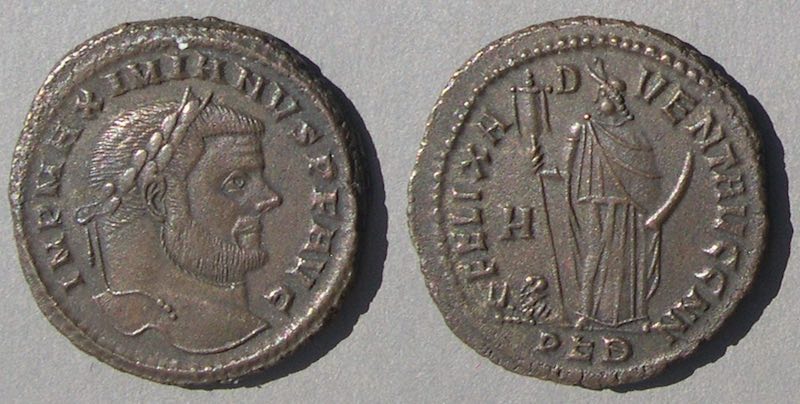
A large 28 mm follis of Maximian, struck c. 298 at Carthage.
IMP MAXIMIANVS PF AVG
FELIX ADVENT AVGG NN, Africa standing front, head left, with elephant-skin headdress, holding standard in right and tusk in left. At feet left, a tiny lion is on a bull with its head and horns visible.
PKB in exergue.
RIC Carthage 25B.
The same type on an argenteus is not illustrated here.
Later Base Silver "argentei": The good-silver argenteus denomination was no longer produced after c. 310. However, at Trier c. 313 a base-silver coin we call an argenteus was issued by Constantine for three rulers--himself, Licinus I, and Maximinus II. Schulten [page 25] says the silver content is about 25%. These three types may be successors to the good-silver argentei, but they surely did not pass for the same value.
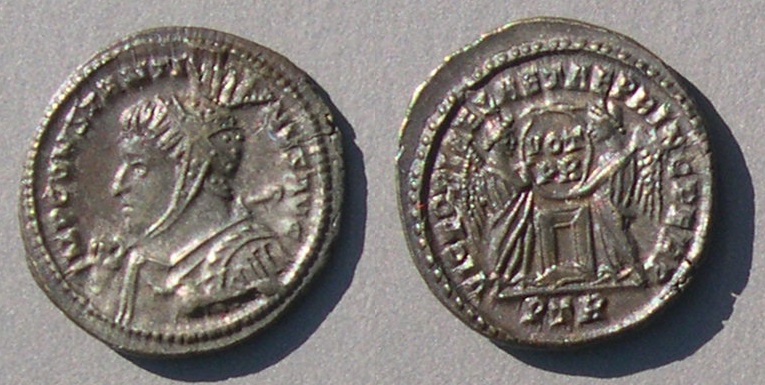
Constantine, struck c. 313-315, issue 16, according to Schulten.
18 mm. Base-silver argenteus, c. 25% silver.
IMP CONSTANTI-NVS AVG
VICTORIAE LAETAE PRINC PERP
Two Victories holding shield inscribed VOT/PR
over altar, PTR in exergue.
RIC VI Trier 208a [318-319]
The metal shows signs of silver, but it seems far from pure.
This type was issued later as a regular AE3 "reduced follis" which makes it hard to be confident this was a different, earlier, issue in a different metal. [See below for AE3s of this type.]
![]() Licinius, struck c. 312-313
Licinius, struck c. 312-313
18 mm. 2.85 grams. Base-silver argenteus, c. 25% silver.
Bust left, laureate, draped, and cuirassed, holding thunderbolt in his right hand and a scepter over his left shoulder.
IMP LIVI-NIVS AVG
Jupiter steaded left on eagle with wings outspread, holding thunderbolt
IOVI CONSERVATORI AVGG
PTR in exergue.
RIC Trier 825 "R3" (but many more found since RIC VI was written.)
Sear IV 15144.
This type is from debased silver. The coins are often porous or rough and rarely look like the metal is good.
Be aware that the same design is used later on similar AE types that do not belong to this issue with silver of "argentei." One is next.
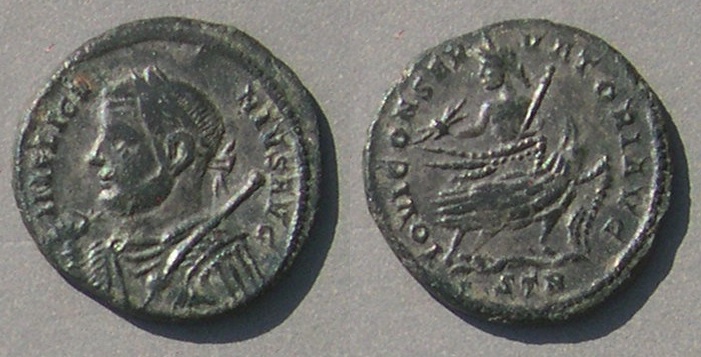
Licinius, struck c. 319.
18 mm. Not a base-silver argenteus, rather a later AE3.
This is very similar to, but not the "argenteus" issue of c. 313 which was only from officina P (and not S, like this one).
IMP LICI-NIVS AVG, bust left holding mappa and scepter across left shoulder
IOVI CONSERVATORI AVG
eagle right on wavy line carrying Jupiter seated left
with thunderbolt in right and long scepter in left, STR in exergue.
RIC VII Trier 212 "r3, 319"
The two similar coins above are in different volumes of RIC. In RIC VI page 224 it is Trier 825, c. 309-313, as a debased argenteus. RIC says "Dr. Bruun has attributed [RIC VI] no. 825 to the period after Maximinus's death, as RIC VII, Trier 212. Our [volume VI, Trier] no. 826 [the next coin] appears to make his attribution unlikely" [because it is issued for Maximinus II who died in 313.] If the next coin is from that same issue, and the quality of the metal suggests it is, Maximinus II must have been alive, at least when the issue started.
When the quality of the metal is not visible, there is little to distinguish the debased argenteus of c. 313 from the later AE3s like the one above. The "argenteus" of Licinius, as those of Constantine above and Maximinus II below, were issued when Trier had only the officina P, and not S as here, so this one above must be later.

Maximinus II, struck c. 313 [Schulten]
18 mm. 2.57 grams. Base-silver argenteus, c. 25% silver.
IMP MAXI-MINVS AVG
Radiate, draped, and cuirassed bust left, right hand raised in front, globe in left.
SOLI INVIC-TO COMITI
Radiate Sol in facing quadriga, globe in his right hand and whip in his left
PTR in exergue.
RIC VI Trier 826, c. 310-313, as Augustus. "r3"
Listed as "base silver" this example gives the impression it is base silver, not just "silvered" as later seen on AE3s.
All three of these argentei are from Trier and have bust left, but the bust types are quite different. RIC VI (1973) puts the Licinius and Maximinus II together in one issue and RIC VII (1966) puts the Constantine with later coins of the same type that are certainly just AE3s. Schulten (1974), however, puts the base-silver of Constantine earlier and I think the first issue of these three types may have formed a single issue of "debased argentei" which began just before the death of Maximinus II in 313.
The Constantine type from Trier as long been regarded as a base silver issue, earlier and distinct from the other usual and very common "two Victories" AE3s that are very similar.
The next two are not argentei (even though they are of Constantine and have the same reverse type as found on the base-argentei of Constantine).
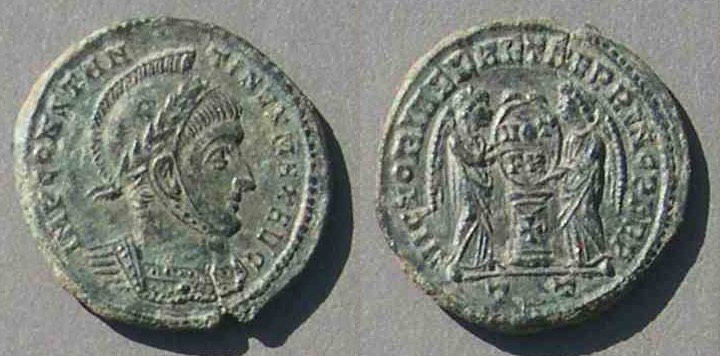
Constantine, struck 318-319 [RIC]
18 mm.
IMP CONSTAN-TINVS MAX AVG
The same reverse type as the Constantine above,
but AE, not base silver.
RIC Ticinum 86.
This type is very common, but this variety with the cross on the altar is not. It is of special interest as an example of early Christian symbolism on Roman coins.
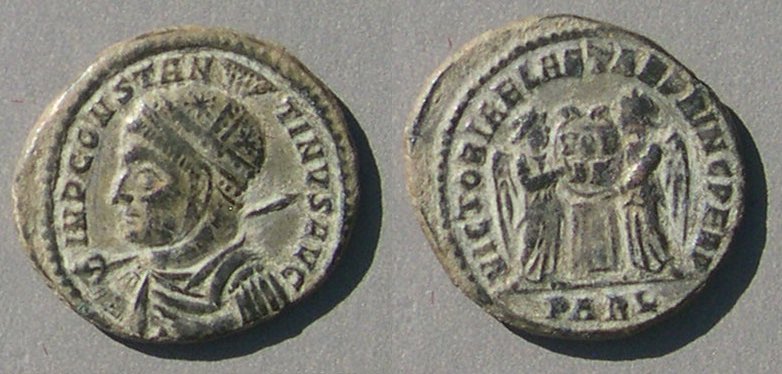
Another Constantine AE3, this one from Arles
19 mm.
RIC Arles 192 "319".
This is not base silver and therefore not an argenteus. Nevertheless, it has a very similar design to the earlier base-silver argentei at Trier (and only at Trier) above.
Note for collectors: The Maximinus II type with the facing quadriga was not used on later AE3s and is so interesting, distinct, and rare that it commands a very large premium. The common Constantine "Two Victories" type is typically very inexpensive, but the "PTR" base-argenteus version also commands a very large premium if the silver-content is visible. The Licinus type with Zeus on a flying eagle was, like the two victories type, issued later and at other mints, so it is less often distinguished as an "argenteus" and does not have much of a premium unless the silver content is evident. For Constantine and Licinus, only the issues from Trier (PTR, STR) have any claim to being base-silver argentei, so only the issues from Trier have a premium.
Conclusion. The argenteus was a new denomination issued by Diocletian c. 294 in nearly pure silver. Silver coins of its quality had not been seen since the time of Nero, more than two hundred years before. The denomination did not endure long and is rare today. Few were issued after c. 300 although it did appear, rarely, until c. 310, and possibly in a much-debased version c. 313. There are only three common good-silver designs ("four sacrificing," "campgate", and XCVI) and the first two occur with four legends each. The few other types are all very rare.
References (in order of relevance, not alphabetically):
Books:
Roman Silver Coins, volume V, Carausius to Romulus Augustus, by Cathy King. Seaby books. Hardback, 1987. 17 of Carausius, 9 of Diocletian, 10 of Maximian, 12 of Constantius I, 11 of Galerius, 1 of Severus II. The book continues on with later silver types. It has a long introduction discussing issues, mints, and types.
The Sisak Hoard of Argentei of the early Tetrarchy, by Aleksander Jelocnik. SITULA 3. Paperback, 1961. A hoard of 1415 coins of which 141 official pieces plus 1 ancient imitation are photographed on 12 page plates, plus three plates of the container in which it was found. Pages 39-69 discuss the coins and mints in English and 74-86 list the 99 varieties in the hoard.
Roman Imperial Coinage (RIC) volume VI. [A nearly complete listing with details of designs, mints, dates, etc.]
Roman Coins and their Values, volume IV, by David Sear. 2011. A nearly complete listing for collectors, with estimated prices.
Compendo de las Monedas del Imperio Romano, volume III, (Diocletian - Constantine II) by Juan R. Cayon. The third of a large four-volume "coins their values" series in Spanish. The book pictures multiple coins of a type if multiple photos were available. It is nearly complete with respect to RIC types, but omits photos of types so rare that photos could not be found. There are numerous photos of argentei [This book is very hard to find]:
31 of Diocletian, 31 of Maximian, 39 of Constantius I, 27 of Galerius, 1 of Severus II, 1 of Maximinus II, 7 of Maxentius
Late Roman Gold and Silver Coins at Dumbarton Oaks: Diocletian to Eugenius. Dumbarton Oaks Papers 18, 1964. Pages 133-236. 18 unnumbered page plates. Only 8 argentei of the tetrarchy, but many silver coins of later emperors.
Hill, Philip. The Monuments of Ancient Rome as Coin Types, hardcover, 1989. Coin 191 on page 99 is an argenteus which illustrates his assertion that it is possible (not certain) that the structure in the "four sacrificing" type is the Praetorian camp, the Castra Praetoria.
Harl, Kenneth W. Coinage in the Roman Economy, 300 BC to AD 700. Hardcover. 1996. 533 pages including 267 coins on 31 page plates and over 100 pages of endnotes. Pages 148ff discuss the reforms of Diocletian, although with an apparent certainty that others would dispute.
Schulten, Peter. Die Romische Munzstatte Trier, 1974, small paperback, 52 pages and 10 page plates.
Callu, J. P. La Politique monetaire des empereurs Romains de 238 a 311." 1969.
Dahm, Murry. "Campgate Bronzes and Roman Fire Signaling." Classicum 30 (2004). Available on Academia.edu
https://www.academia.edu/17075804/CLASSICVM_30_2004_Campgate_Bronzes_and_Roman_Fire_Signalling_
Callu, J. P., Cl. Brenot, and J. N. Barrandon, "Analyses de Series Atypiques" QT 8 (1979) pp.241-254. [XI and IA marked coins are analyzed and found to have about 9% silver.]
Bruun, Patrick. "The successive monetrary reforms of Diocletian," ANSMN 24 (1979), pages 129-148 and plates 32-33. [He writes the first series of argentei is from Siscia without the Caesars and threrefore before March 1, 293.]
Esty, Warren. "The contribution of surface-silvering to Silver Content" in Numismatic Chronicle 1991, pages 226-228.
Esty, Warren, Dick Smith, and Nancy Equal. "The alloy of the "XI" coins of Tacitus." Numismatic Chronicle 1993, pages 201-204. [XI and IA marked coins are analyzed and found to have greater variation than found by Callu et al, but their main point that the silver content of the XI coins is about twice that of the XXI coins is assured. The higher value of the XI coins than the similar XXI coins makes it certain that X is not a multiple of a smaller unit, rather a number required to make a larger unit, somewhat like XCVI means 96 make a pound.]
Sale Catalogs:
M&M Basel. XIII (17-19 June 1954) VHV. MQP. 1051 ancients among 1225 on 36 ppl + 2 E among 48. A spectacular collection of coins of the tetrarchy, including very many rare copper fractional pieces and many silver argentei and many antoniniani. Also some late Roman gold, 99 outstanding PR, 260 G. [This catalog is very hard to find]
Tetrarchy (345), including late Roman fractions (78) and silver argentei (129 regular and 20 irregular)
Nomos
3 (2011, May 10) VHV. VHQP. 259 ancients among 263. 2 Celtic, 159 G, 10 RR, 79 RI including 41 argentei from "the tetrarchy collection", 6 Byz, 3 Merovingian
late Roman argentei (41)
Freeman & Sear
11 (23 Nov. 2004) MV. HQP. 479 ancients among 490, illustrated throughout, some with enlargements, plus 8 ppl of color enlargements. 2 Celtic, 218 G, 19 RP, 44 RR, 179 RI (including 35 argentei), 16 Byz
late Roman silver argentei (35)
12 (2005, Oct. 28) MV. HQP. 656 ancients among 684. B&W photos throughout with some enlargements, plus 7 ppl of color enlargements. 12 Celtic, 240 G, 13 RP, 257 RR, 118 RI (including 38 argentei of the tetrarchy), 11 Byz
Roman Republican (257), argentei of the tetrarchy (38)
16 (2009, June 5) MV. MQP. 469 ancients, plus some unpictured large lots, in B&W thoughout with many enlargements plus 6 color ppl E. 257 G, 12 India, 27 RR, 142 RI including 47 argentei, 25 Byz.
late Roman silver argentei (47)
Freeman &Sear Manhattan Sale 3 (2012, Jan. 3) 236 ancients, all in color and almost all enlarged in color. HV. HQP. 52 Celtic, 69 G, 18 Punic, 8 RR, 62 RI including 22 argentii and 9 later Roman silver, 10 Byz, 1 Arabic
Celtic (52), Roman argentii of the tetrarchy (22)
Gemini (a joint offering of Freeman & Sear and Harlan J. Berk during the New York International show)
I (2005, Jan. 11-12) HV. HQP. 530 ancients among 618. B&W throughout, some with enlargements of one side, plus 6 ppl of color enlargements. 10 Celtic, 260 G, 47 RR, 1 Marc Antony forger's die, 1 military diploma, 199 RI (including 21 late Roman argentei), 28 Byz, 1 DA.
late Roman argentei (21)
M&M Basel. XVII (1957, 2-4 Dec.) HV. MQP. 520 ancients among 1031 on 17 ppl among 46 + 1 E among 2. 195 RR, 312 RI (including 32 argentei and 55 late Roman gold), 10 contorniates,194 RP, 31 Carolingian, 130 early German.
Contorniates (10), argentei (32) and late Roman gold (55)
M&M fixed price list 297, 12 argentei plus 22 later Roman silver
list 381, 17 lots
NAC 84 (2015, May 2021) in two parts. Part I: HV. VHQP. 837 ancients. 234 G including 23 silver fractions of the southwestern Levant), 111 RR, 442 RI including 22 argentii, 11 DA, 30 Byz
argentei (22)
Leu and M&M
Sammlung Niggler, part 3: (11/67) VHV Roman "after Augustus". 526 Roman on 32 ppl.
Trajan, Hadrian, and Antoninus Pius sestertii, several AE medallions, late Roman argentei (19), late Roman silver and gold, 17 contorniates.
Return to the main Table of Contents page for this educational site.
Go to a page of links to pages on the tetarchies, 284-324.